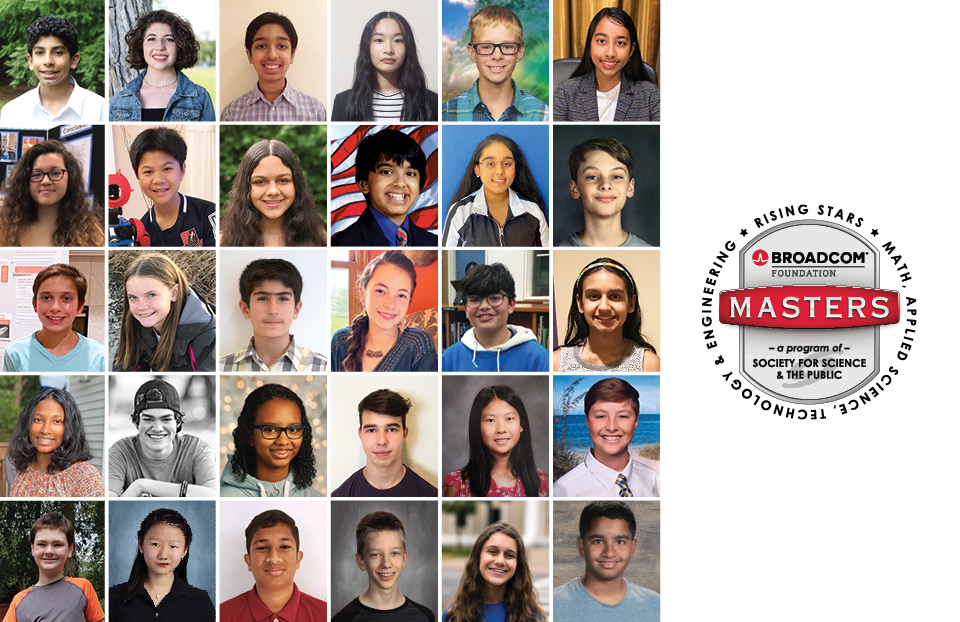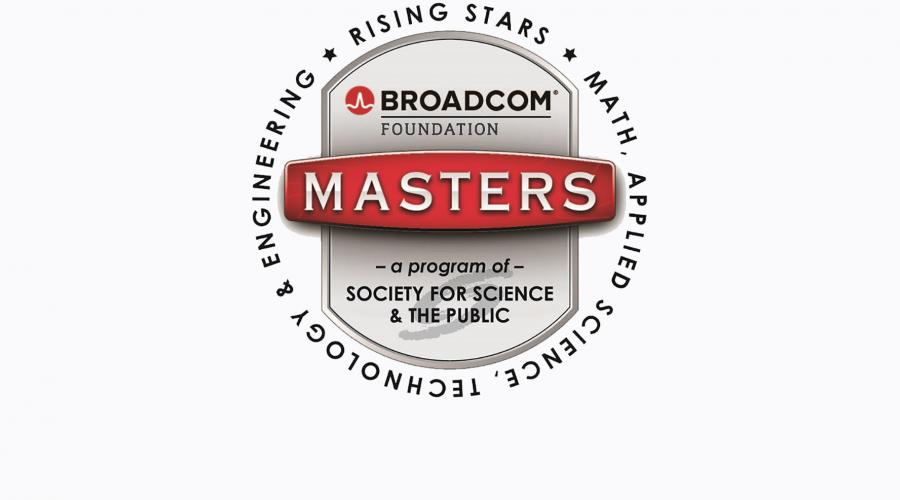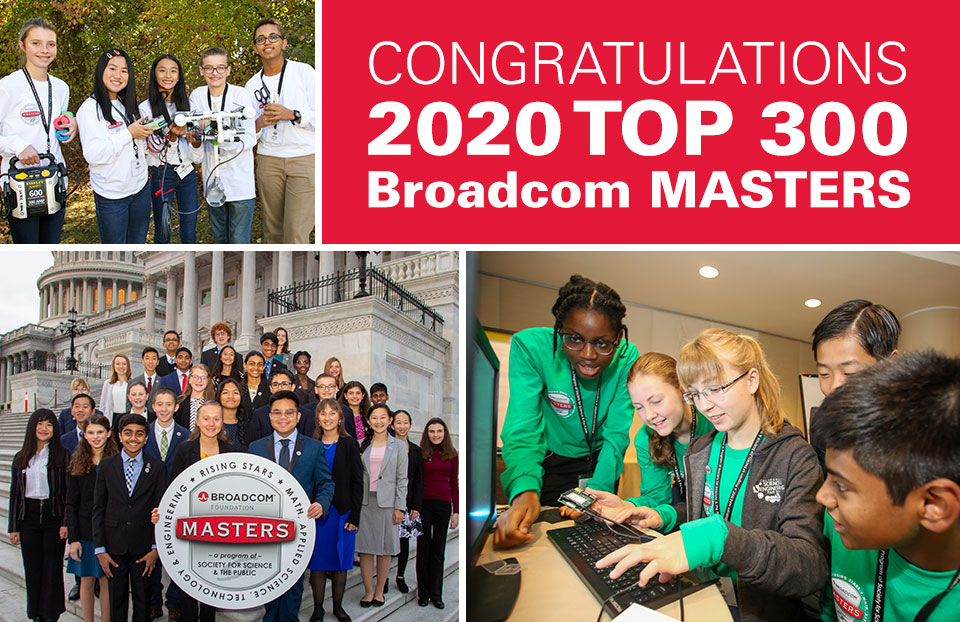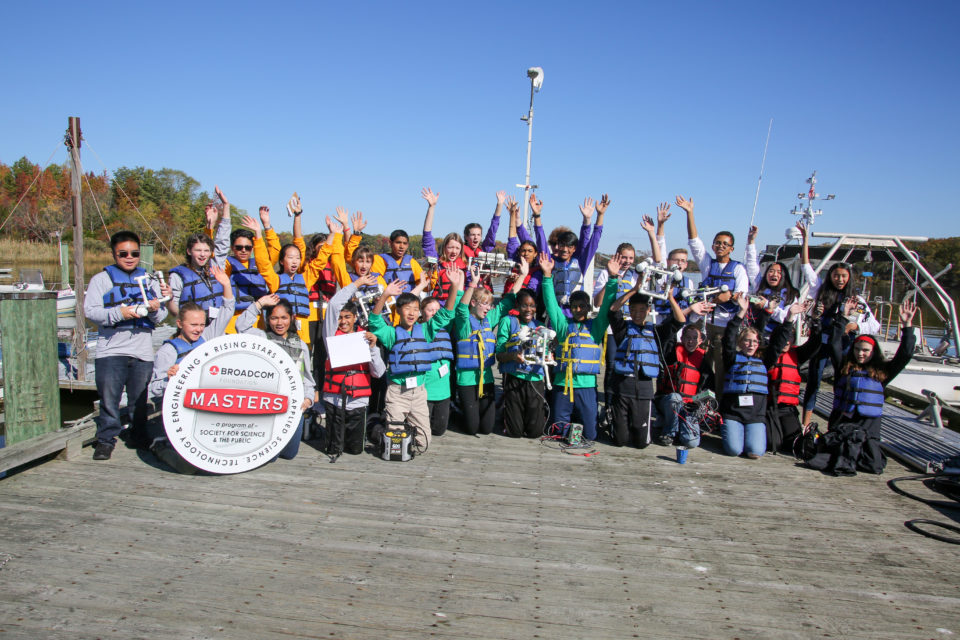2020 Broadcom MASTERS Winners and Finalists
Society for Science and Broadcom Foundation are proud to announce the 30 finalists in the 2020 Broadcom MASTERS® — the nation’s premier STEM competition for middle school students. The finalists competed in the first ever Virtual Broadcom MASTERS from October 16-21, participated in team challenges in addition to being judged on their science research projects.
The finalists include 14 girls and 16 boys covering 16 states and representing 29 schools. All finalists received a $500 cash award and competed for over $100,000 in prizes.
View the Press ReleaseMeet the 2020 Winners and Finalists!
The Samueli Foundation Prize: $25,000
Ishana Kumar
6th Grade, Robert E. Bell Middle School
Chappaqua, New York
Color Is in the Eye of the Beholder: The Role of Retinal Fatigue on Imaginary Fechner Colors
Project Background: “I have always been fascinated about how our complicated brains can be tricked by illusions,” Ishana says. In 1838, psychologist Gustav Fechner found that alternating patterns of black and white can sometimes cause people to see colors. Later, Charles Benham designed a spinning top to induce the effect. Half of Benham’s disk is black. The other half is white with narrow arcs of black. There isn’t a definitive explanation for why the illusion happens. Ishana wondered if retinal fatigue plays a role. That phenomenon happens if someone stares at a brightly lit, colored area for a while. That tires the specialized cells in the eye that detect the color, called cones. Until they recover, normal color perception can be thrown off.
Tactics and Results: Ishana collected data from ten people about the colors they saw when the Benham’s disk spun at a fixed speed. For each person, she then tired their cones that detect red for 30, 60 or 120 seconds. After each time, she showed the Benham’s disk again and asked about what people saw. She also noted how long it took for the original colors to return in the illusion. She repeated the process for the cones that detect blue. And she did the same thing again for the cones that detect green. The data showed a change in color perception in 83 percent of the 90 trials. But the changes that people reported varied. “This suggests that the cones interact with each other,” Ishana says. “Specifically, with some subjects, all of the colors on the Benham’s Disk changed, not just the color corresponding to the saturated cone.” For other subjects, only the color for the fatigued cones changed. Also, the time for the original colors to return generally got longer as the saturation time increased. But red was an exception. Continued work might lead to better ways to diagnose eye disorders, Ishana suggests.
Other Interests: “Without flute and fencing, my life would B-flat and pointless!” Ishana says. She’s also active in her school’s environmental club.
Career Interest: Ishana hopes to become a surgeon. “I hope someday to perform research and surgery to help people with neuro-visual and other brain perception disorders,” she says.
DoD STEM Talent Award: $10,000
Charlotte Lenore Simon Michaluk
8th Grade, Timberlane Middle School
Pennington, New Jersey
Simulating Slipping Snails: Mitigating Climate Change and Oceanborne Invasive Species Transport with Biomimicry
Project Background: Charlotte volunteers with a local environmental group. She’s also a certified SCUBA diver. Experiences in both areas led her to ponder the problem of biofouling. Biofouling happens when algae, bacteria or barnacles build up on ship hulls, buoys and underwater pipes. Scrubbing the slime and critters off is costly. Biofouling also cuts down on ships’ fuel efficiency. Different products exist to protect ship hulls, but some older products are toxic, she notes. As a diver, Charlotte has seen many fish and other aquatic species that have their own ways to prevent biofouling. For example, some species make slimy coatings. And some sharks have tooth-like scales, called denticles. Charlotte wondered if something similar could keep ship hulls clean.
Tactics and Results: Charlotte compared how bladder snails attached and clung to different test surfaces. Some of the surfaces had metal coatings, while others had plastic coatings. Among the plain coatings tested, the one that worked best is a type of silicone called PDMS. Charlotte also tested PDMS coatings covered with different shark-like denticles made from another common plastic. The sizes were based on the shortfin mako shark, the great hammerhead and the leopard shark. The PDMS coating with denticles like the shortfin mako shark did the best job. It kept the most snails off when water flowed. But biofouling isn’t the only issue for ships. Drag happens when friction from a fluid slows a moving object. To measure it for different coatings, Charlotte put each test surface on a scale with a 35-degree wedge. She let water flow over each surface at a steady rate. Then she measured the force of the flowing water that was transferred to each surface. Again, the best performance came from the PDMS coating with denticles like the shortfin mako shark.
Other Interests: Charlotte has a black belt in Taekwondo. She also dances and is active in a variety of sports. She has had several singing and acting roles, including one for a television commercial.
Career Interest: Charlotte hopes to become a materials scientist. “I am fascinated by the substances that create our physical world and enable the next generation of engineering designs,” she says.
Lemelson Award for Invention: $10,000
Julian Olschwang
8th Grade, Rabbi Jacob Pressman Academy
Los Angeles, California
Talk to the Hand
Project Background: About five percent of the world’s people are deaf or have hearing problems. That’s about 466 million people, according to the World Health Organization. “These individuals are not able to communicate easily with people that they encounter every day, like cashiers or teachers,” Julian says. There are already some prototypes for a glove that could convert sign language to text or speech. But those devices generally cost too much, Julian says. Or, they’re not portable or available to the general public. He wanted to make a lower-cost device with easy-to-get materials. The device could help hearing-impaired children in schools, he says. It could also help other people in everyday life.
Tactics and Results: Julian’s sign language glove works with software he wrote for an Arduino circuit board. Those instructions include details for each symbol or letter in American Sign Language. Julian also put flex sensors on the glove. The glove “measures how far each finger is bending by the resistance in the sensor,” he explains. Then it converts the resistance into a number. When readings for the fingers’ positions line up with the parameters for a particular letter or symbol, the system reports that as its output. “It took me five months before it worked correctly to interpret one letter, the letter A,” Julian says. Getting to that point took many trials to correct hundreds of error messages. Julian fixed those errors and kept doing testing. He also wound up creating a troubleshooting code. That tool helped him spot which fingers caused different problems. He hopes to program a glove for the rest of the alphabet, so the glove can become a practical tool. He also hopes to develop an app that can connect with the glove remotely. This would make it easier to use with a mobile phone.
Other Interests: Julian rides his skateboard for about two hours each day. He also stays active with soccer, basketball and boxing. He plays the violin and piano as well.
Career Interest: Julian hopes to become a theoretical physicist. “I love to tackle questions about the universe, our origins and our trajectory as a species,” he says.
Marconi/Samueli Award for Innovation: $10,000
Kai Vernooy
8th Grade, Iroquois Middle School
Niskayuna, New York
Hacking the Election: Measuring and Solving Gerrymandering in Today’s Political System
Project Background: Democratic principles hold that each person’s vote should be weighted equally. Gerrymandering runs counter to that, say critics. Gerrymandering happens when voting district lines give an overall advantage to one political party or group. “It allows politicians to pick their voters, not the other way around,” says Kai. “Given the upcoming election, it is an increasingly pressing problem.” And states will redraw their voting districts next year, based on 2020 Census numbers. Different methods to flag unfair voting maps often aren’t accessible, Kai says. Or, the results can be inconsistent. More importantly, he adds, current methods generally don’t consider the communities that are hurt by unfair voting districts. He worked with teammates to find a better way to spot gerrymandering and on how to fix it.
Tactics and Results: Kai and his teammates worked with tools from different areas of math. One of their algorithms draws optimal precincts or districts. It aims to have equal numbers of people in each area. It also tries to make the precincts geographically compact. That’s based on how geometrically close each area is to a circle. The algorithm also uses census information and other data to define communities. Those are “geographic regions of like-minded voters,” Kai explains. The algorithm tries to minimize the standard deviation for partisanship in each area. The team also wrote algorithms to rate the actual voting districts for a state. The program looks for the percentage of people in a community who aren’t represented by their district. If there’s no gerrymandering, that percentage should be minimized across all districts. The team’s tools flagged extreme gerrymandering in a couple of well-known cases. So far, the group has used its program to analyze the voting maps for 26 states. Kai hopes to expand the work to all 50 states after results of the 2020 U.S. census are reported.
Other Interests: “I most enjoy playing the violin,” Kai says. He also plays soccer and volleyball and enjoys cycling as well.
Career Interest: Kai hopes to become a cartographer. That work deals with making maps. Kai likes how the field combines the use of data with design and aesthetics to convey spatial information.
Robert Wood Johnson Foundation Award for Health Advancement: $10,000
Zoe Weissman
8th Grade, American Heritage School
Plantation, Florida
Testing Phytochemicals for Antinociceptive Properties in Both Female and Male Drosophila melanogaster in Order to Discover a Natural Painkiller and Reduce Bias in the Drug Industry
Project Background: “I wanted to find a potential alternative to opioids that could treat males and females equally,” Zoe says. Ideally, she hoped to do that with plant-based chemicals. She also wanted to make sure the chemicals would help both sexes. On average, she learned, men and women often perceive pain differently. However, clinical trials for new drugs have tended to use more men than women. That habit came about from a now-disproven notion that women’s hormone cycles make them harder to work with. As a result, more pain medicines are geared towards men, Zoe notes. In her view, that’s unfair to women. It can also pose dangers if harmful side effects go unnoticed.
Tactics and Results: Zoe tested three plant-based chemicals on male and female fruit fly larvae. Salicin comes from willow bark and some other trees. Caffeine comes from coffee beans, tea leaves, cocoa beans, kola nuts and other sources. Finally, cinnamic acid comes from cinnamon and some other trees. To test each chemical, Zoe used separate groups of male and female larvae. She also treated groups of males and females with acetaminophen, an over-the-counter pain reliever. Control groups for each sex got no treatment. Zoe first measured the temperature at which larvae in different groups reacted to heated water. Another test counted how many insects in each of the ten groups flew past a hot zone to get to a source of light. In a third test, she poked larvae with a small filament. She noted if the insect reacted to the stimulus within 10 seconds. All three plant-based treatments reduced the male and female flies’ pain compared to the control groups. Among the three plant-based treatments, salicin worked best for both the hot water and the poking tests. Cinnamic acid was the best plant-based treatment to let flies move towards the light.
Other Interests: Zoe volunteers with a program to build friendship with kids who have special needs. She has also been a chapter president of March for Our Lives.
Career Interest: “I dream of becoming a pediatric heart surgeon,” says Zoe. She looks forward to hands-on work that can help save patients’ lives.
STEM Award Winners: Science Award, First place
Logan Silvea
7th Grade, Holy Trinity Episcopal Academy
Melbourne, Florida
Correlation Between Interocular Signal Delay and Luminosity, Measured Through the Perceived Intensity of the Pulfrich Effect, Noting the Impact of Ocular Dominance (2 Year Study – Psychological Adaptations and Optical Illusions)
Project Background: Logan was born with only 20/100 vision in both eyes. But he didn’t realize it until third grade. “I was able to read, hit a baseball and do many other normal activities,” he explains. Basically, his brain had been adapting and filling in many of the visual gaps. When Logan learned that, he became interested in optical illusions. For his project, he tested a phenomenon called the Pulfrich Effect. It makes images moving from side to side on a flat screen seem to be in 3D. The trick calls for the use of a darker filter for one eye.
Tactics and Results: The Pulfrich effect works because of how the brain handles signals from the eyes. A darker filter for just one eye causes a tiny time delay in when the brain gets information from that eye. Meanwhile, the brain is processing signals from the other eye. The brain thus processes two images at once. So, if a pendulum moves from side to side on a flat surface, a person’s brain interprets that as 3D motion. Logan mounted a movable pendulum on flat poster board. Forty-one people then viewed the moving pendulum while wearing different sets of sunglasses. Each pair let a different level of light reach either the left or right eye. People perceived the 3D effect as being most intense when they viewed the illusion with glasses having the darkest filter for one eye, Logan reports. He also saw a correlation between the intensity of the effect and people’s eye dominance. About 60 percent of the subjects perceived the greatest impact when their weaker eye had the darker filter. Better understanding about how the brain deals with visual signals might help to screen and treat various physical and mental conditions, Logan says.
Other Interests: Logan plays quarterback for his football team and shortstop on his baseball team. He also enjoys fishing, playing the guitar and painting ocean scenes.
Career Interest: Logan hopes to become a neurologist. “I want to understand how our brain receives new information and interprets that information.”
STEM Award Winners: Science Award, Second place
Madilyne Kay Beaudry
8th Grade, Saint Joseph Catholic Middle School
Ogden, Utah
Bioplastic Development; Yielding Lactic Acid Using Compost
Project Background: Every day, people in Utah send an average of about five pounds of waste per person to landfills. “Much of this comes from single-use plastics, which could easily be replaced by bioplastics,” says Madilyne. Bioplastics are made with materials from renewable resources, instead of fossil fuels. One example is polylactic acid, or PLA. That plastic is durable and works in 3D printing. The waste could also be recycled if it were sorted properly, she notes. However, lots of PLA comes from fermented corn or sugar. Those crops need land for growing, and that can have impacts on the environment. Corn and sugar also have other uses. So, Madilyne set out to make PLA from something that was otherwise going to be thrown away — compost materials.
Tactics and Results: The fermentation of sugars from corn or sugarcane produces lactic acid. That’s the basic chemical building block for PLA. For her tests, Madilyne mixed, dried and ground raw fruit and vegetable material to simulate compost. She then used a type of bacteria, called Lactobacillus buchneri, to ferment the sugars in her compost mix. That type of bacteria “yields one molecule of carbon dioxide for every molecule of lactic acid” it makes from glucose, she explains. She rigged up degasser devices similar to coffee degreasers. Those devices would collect the carbon dioxide gas as the compost mix fermented. Then she set up three of the degassers under a heating lamp. One had her compost mix with the bacteria, one had glucose and the bacteria and the third had just the bacteria, as a control. Madilyne calculated how many grams of carbon dioxide each device collected. Based on that, she figured out how many grams of lactic acid each feedstock produced. “The compost sample yielded three times what the control yielded,” she reports and it produced one-and-a-half times as much lactic acid as the glucose did.
Other Interests: Madilyne loves to go mountain-biking on trails and then read in nature. She also enjoys writing, art and painting clothing. She plays soccer and does weightlifting as well.
Career Interest: Madilyne hopes to become a biomedical engineer. She especially hopes to find new ways to help people with mental health problems.
STEM Award Winners: Technology Award, First place
Amelia Belle Curran
8th Grade, Herbert C. Hoover Middle School
Indialantic, Florida
Comparing the Efficiency, Free Fatty Acid Percentage, and Carbon Dioxide Emissions of Waste Vegetable Oil and Ethiopian Mustard (Brassica carinata) Biodiesels
Project Background: Amelia learned a lot about car engines and fuels from her dad, who’s a retired race car driver. Most cars run on gasoline. Along with emissions from other fossil fuels, these are the main drivers of human-caused climate change. “We must take action to reduce our carbon footprint on this Earth,” Amelia says. Biofuels are a possible alternative fuel for cars and trucks. Biofuels are made with materials from plants and other organisms. In some instances, burning them emits less carbon dioxide than regular gasoline. Using biofuels can also avoid fugitive emissions and other pollution from mining or drilling. Amelia wanted to compare homemade biofuels from two plant-based oils. Ethiopian mustard is an oilseed crop, and waste vegetable oil is used cooking oil.
Tactics and Results: First Amelia made her biofuels. She extracted oil from Ethiopian mustard seeds. She also cleaned up the waste vegetable oil and adjusted its level of free fatty acids. Next, Amelia reacted each type of oil with sodium hydroxide, methanol and triglycerides. That process produced fatty esters for her two biofuels. Once the fuels were made, Amelia compared them with typical auto gasoline. First, she tested the fuels’ energy content. She burned a small amount of each fuel in a tea candle holder. A metal can of water sat above the flame. After a minute, she extinguished the fire. She measured the change in the water’s temperature. Then she converted that into units of energy called joules. Amelia’s waste oil fuel wouldn’t burn. The gasoline produced more energy than the mustard seed oil fuel. However, that difference wasn’t statistically significant. In another round of tests, Amelia collected smoke from the burning fuels. Then she figured out how much carbon dioxide was emitted. Her fuel made with mustard seed oil gave off significantly less carbon dioxide than the gasoline.
Other Interests: “I have been dancing since I was three years old,” Amelia says. Her other hobbies are playing the piano and guitar and singing in a choir.
Career Interest: Amelia is especially interested in criminal and abnormal psychology and wants to pursue a career in criminal justice.
STEM Award Winners: Technology Award, Second place
Pauline Victoria Allasas Estrada
7th Grade, Granite Ridge Intermediate School
Fresno, California
Real-Time Detection of Drought Stress in Plants Using a Custom-Built Infrared Sensing Rover
Project Background: “Prolonged droughts are becoming a common occurrence in California,” Pauline says. California’s Central Valley has been especially hard hit at times. That area produces most of the United States’ almonds. Farmers there also grow huge amounts of grapes and other fruits and vegetables. Pauline wanted to help farmers manage their water use more efficiently. The infrared energy from a plant’s leaves can indicate how much drought stress it is experiencing. But commercial infrared cameras are expensive. And computer systems using them often don’t provide enough detail. They have trouble figuring out the temperatures for plants’ leaf canopies on a pixel-by-pixel basis. Pauline set out to make a system that would be less expensive and perform better.
Tactics and Results: Pauline built her own infrared camera. She mounted it on a remotely operated vehicle, or rover, she had previously built. And she programmed an on-board computer to work with the camera. Her program uses information from infrared images of pepper plants to figure out a plant’s crop water stress index, or CWSI. To test the system, she grew eight pepper plants in pots. She gave the plants different amounts of water, which led to different degrees of drought stress. There was a strong inverse relationship between the CSWI reading and the soil moisture level, Pauline noted. She then put the potted plants in a research area at California State University – Fresno. She used her rover to collect additional data on the plants in the field. She also compared its crop water stress index findings to the measured soil moisture. “The rover worked well and its camera gave higher-resolution images than an expensive commercial camera,” Pauline reports. Remote operation of the rover can also minimize person-to-person contact in the field. “That matters during a health emergency, such as the COVID-19 pandemic,” she says.
Other Interests: “I enjoy dancing ballet,” Pauline says. It teaches me important life skills, like never giving up and always trying her best. “It also lets me express myself through my body,” she adds. Pauline also swims and runs track and cross-country. She plays piano and viola as well.
Career Interest: Pauline hopes to become an oncologist. That’s a medical doctor who specializes in treating cancer.
STEM Award Winners: Engineering Award, First place
Anita Gaenko
8th Grade, Clague Middle School
Ann Arbor, Michigan
Not All That Is Yellow Is Turmeric: Designing Analytical Chemistry Methods and Photometric Circuitry to Detect Lead Chromate Adulteration of Turmeric
Project Background: Turmeric is a spice used in many recipes from India, other parts of South Asia and the Caribbean. Scientists are also doing research on various medical uses for the spice. However, Anita learned, not all turmeric was pure. Some suppliers in India were using lead chromate in their processing. The additive brightened the spice’s yellow color, but it also added a lead compound that has toxic effects. But how might people know if their turmeric was adulterated? “I got the idea to use chemical methods to determine whether a certain sample of turmeric was contaminated,” Anita says. She teamed up with Akshar Cowlagi to put the idea to work.
Tactics and Results: The team tested two ways to detect lead chromate in turmeric. One method added chlorine bleach to a turmeric sample mixed with water. “Bleach turns the turmeric white, but doesn’t bleach lead chromate,” Anita explains. The other testing method used enzyme chemistry. A compound in turmeric turns red in a basic environment. And lead chromate will inactivate an enzyme that makes urea produce ammonia, which is a base. So, a sample with lead chromate should stop a mix of turmeric, urea and urease from turning red, the team reasoned. Each method calls for looking at the intensity of a color. The team built a device to measure that. Light shines through a sample solution and a blue filter. A photoresistor measures the intensity of the light, and the device converts that to numerical information. The device then compares the number to a threshold level for contamination. A contaminated sample makes a red light come on. Of the two approaches, the bleaching method worked much better, Anita and Akshar report. Its results could only be two shades of color, versus a wider range.
Other Interests: “The extra-curricular activities I enjoy most are playing the piano, dancing and writing,” Anita says. She is currently learning a style of dance from South India.
Career Interest: Anita hopes to become a biomedical engineer. “I enjoy engineering and computer science projects, and I’m interested in medicine and cell biology,” she says.
STEM Award Winners: Engineering Award, Second place
JT Mulvihill
8th Grade, Arizona College Prep – Oakland
Chandler, Arizona
Designing a Football Helmet Lining and Coating for Maximum Rotational and Linear Impact Force Reduction
Project Background: JT loved playing football. But a serious eye problem left him legally blind in one eye. Although he can’t play football any more, he is using science and engineering to stay in the game. He wants to make a safer football helmet. Last year he studied materials that could cushion an impact. This year, he worked on designing a helmet lining and coating with his chosen material. The goal is to maximize the helmet’s ability to withstand different kinds of forces. That includes direct, frontal hits, which are linear forces. It also includes rotational, or twisting, forces. Those forces make a helmet slide to the side when there’s an impact.
Tactics and Results: JT lined and coated several standard football helmets with a visco-elastic gel polymer, a type of plastic. Elastic refers to a material’s ability to bounce back to its original shape after a stress. And visco- means something is viscous, or resistant to flowing. He put accelerometers inside a testing head. Those devices measure changes in acceleration and help detect shifts in position. Then he used a lab pendulum to swing at the first helmet at different speeds. After multiple trials, he adjusted the design for the next test helmet. He then did multiple trials at different speeds with that helmet. He repeated the process with a third helmet. The fourth helmet model had an external coating, but not an inside lining. Weight seemed to affect how well the helmets performed. “The lighter exterior coated helmet performed the best out of all the helmets,” JT reports. His next step would be to experiment with a honeycomb design for the lining or coating. He hopes it will lighten the helmet’s weight, while still providing protection for the wearer.
Other Interests: JT loves flowboarding. It’s like surfing, skateboarding or bodyboarding in an artificial wave machine. “I live a few miles from a municipal-owned FlowRider and can ride all the time!” he says.
Career Interest: JT hopes to become a marine biologist. “I have always been fascinated by the ocean, its ecosystems, the back bays and sharks,” he says.
STEM Award Winners: Mathematics Award, First place
Sina Sean Kassayan
8th Grade, La Entrada Middle School
Menlo Park, California
Biometric Authentication in a Heartbeat: An Artificial Intelligence Deep Learning-Based Heart Sound Authentication System
Project Background: Data breaches cost people and businesses billions of dollars each year. Better digital security systems can help cut those costs. Biometric authentication is one type of added layer beyond simple usernames and passwords. It’s “the process by which our physical characteristics are used to prove our identity,” says Sina. Existing systems focus on fingerprints, voices, irises and other features. Sina set out to do something similar based on the sounds of people’s hearts. “Our heart sound is unique but cannot be altered or disguised,” he says. Last year he worked on a more cost-efficient way to take ECGs, or echocardiograms. These recordings of the heart’s electrical signals reflect various health conditions.
Tactics and Results: “I designed and built an AI-enabled system to record, process, train and identify heart sounds,” Sina says. AI stands for artificial intelligence. To start, he built an electronic stethoscope, which detects the sounds of a person’s heart. He made digital recordings of three people’s heartbeats while they were at rest. He worked with the data to amplify it, while also removing sounds above a certain level. Then he used an algorithm to translate the sounds into frequency data. And he used software to identify various features from the sound data. Sina then used those features to train an artificial intelligence model. Each round of training helped the model improve its accuracy in matching heartbeat sounds to a person. After training, he tested the model with a new dataset of heartbeat sounds. The system correctly identified all three people from their heartbeats, he reports. For future studies, he would include more participants. He also would test if the system could still work well if the heart sounds were recorded under different conditions.
Other Interests: “One of my favorite activities is water polo,” Sina says. He also enjoys backcountry skiing. “You strap climbing skins to your skis and climb up a mountain instead of taking a chairlift up,” he explains. He also swims and practices Kuk Sool Won, a type of Korean martial art.
Career Interest: Sina hopes to become an electrical engineer. The field “combines elements of technology, engineering, and math, and can be applied to many situations in scientific fields,” he says.
STEM Award Winners: Mathematics Award, Second place
Joshua W. Cox
7th Grade, Buckeye Valley Middle School
Delaware, Ohio
Lift Off! Finding Rockets Using Sound Waves
Project Background: “I love space, from astrophysics to the Apollo missions,” says Joshua. He also has an interest in his dad’s work as a sound engineer for Honda. That got him thinking about how sounds can help locate objects. When submarines use sonar, for example, they bounce sound waves off things to figure out where underwater hazards might be. Joshua decided to see if he could figure out where a rocket launched from, based on its sound. A similar approach could also help military bases protect themselves, he says. The project would let him experiment with microphones and decibel readings. And it would give him an opportunity to shoot off model rockets.
Tactics and Results: Joshua knew that the sound pressure measured by a microphone would correlate with its distance from a sound’s source. He also was able to measure the sound pressure level of a model rocket one meter away from its source. That information could help him use the decibel reading from a microphone to figure out its distance from the source of a sound. Additionally, he knew the sound from an object would reach mics in different spots at slightly different times. That could let him figure out the direction from which a sound came. He placed four mics one-meter north, south, east and west of the center of his test area. Then he placed a launch pad with model rockets at different places around the test area. At each spot, he used a tape measure and compass to find the distance and angle of direction from the center. Then he launched a rocket and recorded the decibel readings for each mic. Joshua made calculations based on the mic readings. Then he compared the results to his manual measurements. The calculations didn’t exactly match up. But they were generally within 10 percent of the actual measurements, he says.
Other Interests: “I take fencing because I love swordplay,” Joshua says. He’s an avid sci-fi fan. He also enjoys drawing, origami and building with LEGOs.
Career Interest: Joshua hopes to become an astrophysicist. “I love astrophysics, astronomy, space science, physics and math.”
Finalist
Ishan Ahluwalia
8th Grade, Stoller Middle School
Portland, Oregon
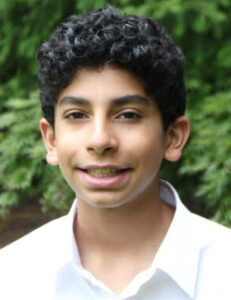
Project Background: Hydroplaning happens when a layer of water makes a vehicle’s tires lose traction. Ishan experienced it several years ago. “One second we were driving normally on a freeway, and the next we were slipping and sliding into the curb,” he recalls. Some warning systems have been designed, but have proven to not be very reliable he says. Ishan decided to design his own warning system. It would detect a reduction in friction and inform the driver before a car starts to slip. He decided to use machine learning with a system that used a 3-axis accelerometer. That device can measure changes in acceleration due to gravity. That, in turn, provides information about the device’s orientation or positioning.
Tactics and Results: The simulated “car” for Ishan’s project was a wooden rig with an attached tire. To mimic a car moving on a road, he placed the rig on a treadmill so the tire could spin. He placed a 3-axis accelerometer near the tire’s axle. That device was hooked up to an Arduino programmable circuit board. That, in turn, connected to his computer. Ishan also set up a hose with small tubes on the treadmill. That let him simulate light rain and heavy rain. He collected between 100 and 200 readings related to friction calculations for each of different weather conditions and speeds of the treadmill. He then used a machine learning toolkit to train his warning system’s artificial intelligence model. He further tweaked the model with an algorithm for time-series comparisons. Its purpose was to reduce meaningless “noise” from the accelerometer’s data. Then Ishan tested his warning system. He created a series of weather conditions and speeds. Then he checked the model’s predictions. His final model had an accuracy rate of 81 percent.
Other Interests: “I enjoy woodworking,” Ishan says. “It’s about being precise, but also about letting your creative muscles improvise.” He plays basketball and tennis. He’s also active with a nonprofit group called Token. The group provides financial help to people in developing countries who have chronic health conditions.
Career Interest: Ishan hopes to become a mechanical engineer. “I’ve always been interested in using design principles and mechanical processes to build new systems and devices for day to day use.”
Finalist
Anish Bhethanabotla
7th Grade, Joaquin Miller Middle School
San Jose, California
AI EYE: Navigation Aid for the Visually Impaired
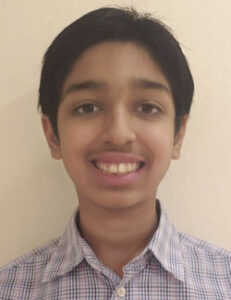
Project Background: “One of the main struggles for the visually impaired is the ability to effectively navigate their surroundings,” Anish says. Sadly, existing solutions often cost too much for many people. Or, they don’t effectively warn someone about obstacles in their path. Anish had read about digital canes to help blind people get around, but he wondered what more could be done. “It wasn’t long before I started thinking of building goggles and helmets that could enable the blind to see,” he says. He then set out to design the AI Eye. The helmet would use artificial intelligence to give users real-time feedback about their surroundings. And it would give alerts about objects in front of the wearer.
Tactics and Results: The helmet for Anish’s AI Eye uses a small computer microcontroller called a Raspberry Pi 4. It also has a camera with an omnivision sensor. Ultrasonic sensors to tell how far away things are. And a small speaker gives feedback to the wearer. Anish designed the AI Eye’s device with an open source machine learning platform called TensorFlow. Anish trained the system with objects in his home, as well as photos he found online. That work taught the system to classify things into five categories. Those groups are vehicles, food, animals, electronic goods and household devices. In testing, the AI Eye worked best at recognizing vehicles. The success rate was 90 percent. The lowest accuracy rate, for animals, was still 84 percent. Just as importantly, the device spotted obstacles 100 percent of the time, Anish reports. Parts for the device cost $120. That makes it “more cost-effective than existing products, ensuring that all visually impaired people can afford a better navigation system,” Anish says.
Other Interests: “One of my favorite hobbies is cubing,” Anish says. He has a collection of about 20 types of Rubik’s cubes. His other hobbies include basketball and tennis.
Career Interest: Anish hopes to become an astronomer. He likes that the field combines math, physics and other aspects of science. Astronomy also explores basic questions, he says. Those include “are we alone?” and “is the universe thoroughly infinite?”
Finalist
Rylan Colbert
7th Grade, Waiakea Intermediate School
Hilo, Hawaii
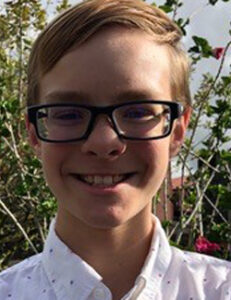
Project Background: “Over the years, glaciers have been melting and compacting more and more,” Rylan says. Compaction happens as the weight of ice and snow at the top of a glacier pushes down on the bottom. And as climate change continues, many glaciers around the world have been shrinking. “What really matters is, how long until there will be no glaciers, and will we have time to change?” he asks. He had read about an experiment in which a scientist watched how bubbles in puffed rice collapsed when soaked and put under pressure. “I wondered what would happen if I recreated that experiment with shaved ice,” he says.
Tactics and Results: Rylan used shaved ice on top of gravel in a beaker to simulate a glacier. He pumped in some cold water and put the beaker in a refrigerator. A video camera connected to a microscope recorded how the ice compacted for 20 minutes. He did this three times. Then he repeated the process with trials for warmer water and with no water. Next, Rylan analyzed the data. The rate of the ice’s compaction was not constant. Compaction took place more quickly early on, compared to later in the process. “This is because there is less room for the ice on the bottom since there is less space for it to go down,” he explains. And the ice with no water compacted the slowest, he notes. He also calculated that glaciers should compact 0.77 percent faster for each degree that the temperature goes up. For a future experiment, he might set up microscopes to examine both the top and bottom of a simulated glacier. That would let him see how the ice compacts in different parts of a glacier.
Other Interests: Rylan enjoys baseball and basketball. He also plays the saxophone and is active in Boy Scouts.
Career Interest: Rylan hopes to become a statistician or possibly another type of mathematician or a physicist. “I like math, and I love to work with numbers and think about what those numbers mean. I also like to work with data and make it intelligible.”
Finalist
Akshar Cowlagi
8th Grade, Clague Middle School
Ann Arbor, Michigan
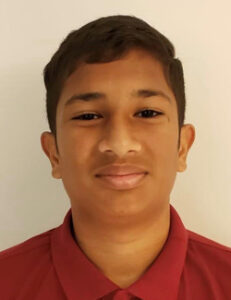
Project Background: Turmeric is used in many recipes from India, other parts of South Asia, and the Caribbean. Scientists are also doing research on various medical uses for the spice. However, Akshar learned, not all turmeric was pure. Some suppliers in India were using lead chromate in their processing. The additive brightened the spice’s yellow color, but it also has toxic effects. “Of all adulterants, lead chromate is one of the most dangerous,” he says. He teamed up with Anita Gaenko to find a way for people to test if their turmeric is contaminated.
Tactics and Results: The team tested two ways to detect lead chromate in turmeric. One method added chlorine bleach to a turmeric sample mixed with water. Bleach will turn the turmeric white, but it won’t change the color of the lead chromate. The other testing method used enzyme chemistry. A compound in turmeric turns red in a basic environment. And lead chromate will inactivate an enzyme that makes urea produce ammonia, which is a base. So, a sample with lead chromate should stop a mix of turmeric, urea and urease from turning red, the team reasoned. Each method calls for looking at the intensity of a color, which the team built a device to measure. Light shines through a sample solution and a blue filter. A photoresistor measures the intensity of the light, and the device converts that to numerical information. The device then compares the number to a threshold level for contamination. A contaminated sample makes a red light come on. Of the two approaches, the bleaching method worked much better, Akshar and Anita report. Its results could only be two shades of color, versus a wider range.
Other Interests: Akshar’s favorite sport is tennis. He also plays soccer and swims. He enjoys Science Olympiad and really likes the challenge of coding and building electronic circuits.
Career Interest: Akshar hopes to become a software engineer. “I can help to engineer and apply software to create games,” he says. “Doesn’t that sound fun?”
Finalist
Richard Deng
7th Grade, ACCESS Academy
Portland, Oregon
Quantum Motions and Emotions for a Humanoid Robot Actor
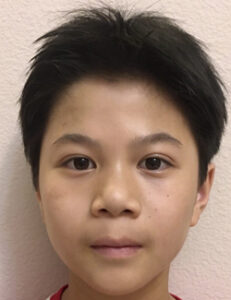
Project Background: Richard saw a video in which someone acted like a robot while dancing to music. Then he thought about how actual robots would dance. Their motions are generally somewhat repetitive, which could make them boring to viewers. The reason, he realized, is their programming. Classical types of programming usually allow just one result for each decision with a series of one-way logic gates. Programming like that used for quantum computing would allow for more possibilities, Richard reasoned. Then the robot’s actions would be less predictable — and more entertaining. He decided, it would be even better if a dancing robot’s actions could synchronize with the music.
Tactics and Results: Regular, “classical” programming would let a robot do a single dance for a song, Richard says. And the programming would only control up to three motors for each time interval in a song. Actual quantum computers need very cold temperatures and tightly controlled conditions for various parts. However, there are some tools for regular computers that use logic similar to that for quantum computers. Richard worked with those tools. His programming converts the musical notes of a song into instructions for a human-like robot. Those instructions can then control multiple motors on the robot. As a result, the robot can make a wider variety of motions than a regular robot can. Up to five motors can change the position of different parts during each time interval in a song. Richard’s programming also controls how the robot shows emotion. As a result, he says, “the same quantum circuit can generate two different dances — a happy dance and a sad dance.” He believes a similar approach also could make a robot do practical tasks. “My next step would be to implement speech and image recognition so that the robot will be able to take orders from its ‘master,” he says.
Other Interests: Soccer is Richard’s favorite extracurricular activity. He also enjoys fencing, swimming, basketball, and track and cross country. He plays the piano too.
Career Interest: Richard hopes to become a computer engineer. “My whole goal is to create a robot with a kind of artificial intelligence that allows it to act like a human and do things that humans can do.”
Finalist
Abhijeet Ghosh
6th Grade, Dodgen Middle School
Marietta, Georgia
Recycling with Artificial Intelligence (AI) and Robotics
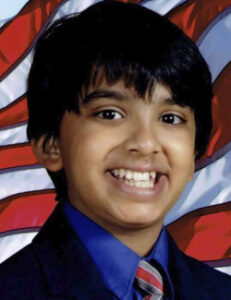
Project Background: Abhijeet is very keen on recycling. Recycling reduces waste, and it has a positive impact on the environment. But, he says, “I have seen that people are not careful enough to put waste in the correct type of bin.” So, some regular trash gets into recycling containers and different types of recyclables are often mixed together. Sorting them out by hand is time-consuming. The process is prone to human error and some contaminants might be hazardous. “Wouldn’t it be more convenient and easier to have one intelligent waste bin that sorts the waste for you?” he asks. He set out to do the job with robotics and artificial intelligence, or AI.
Tactics and Results: Abhijeet wrote a computer program to work with Google’s TensorFlow image classification model. Then he trained the model with hundreds of pictures of waste items. The training taught the model to recognize six categories of waste. He then tested the system’s ability to classify day-to-day waste items with pictures that weren’t part of the training process. Next, Abhijeet combined his artificial intelligence model with a robot. Its parts include LEGO Mindstorms pieces, a camera, sensors and a Raspberry Pi. The Raspberry Pi is “a credit-card-sized, yet powerful computer,” Abhijeet explains. A motion detector tells the robot when someone puts a piece of trash on it. The robot takes a picture of the waste. Its AI model decides what type of waste the item is. Then the robot dumps the waste into its proper bin. When Ahibjeet tested the robot, it correctly classified 90 out of 104 items. He thinks a computer with more processing power would have been able to use more images for the training process. An autofocus or near-focus camera could also improve accuracy, he thinks.
Other Interests: “One of my favorite hobbies is making my house smart,” Abhijeet says. Some of his computer routines control devices by voice. Other routines tell devices to do multiple tasks at the same time. He plays piano and guitar and sings in a choir.
Career Interest: “I have always wanted to become a doctor,” Abhijeet says. He would especially like to become a neurosurgeon. “I love to do precise, challenging work.”
Finalist
Vivaana Haval
7th Grade, Metrolina Regional Scholars Academy
Charlotte, North Carolina
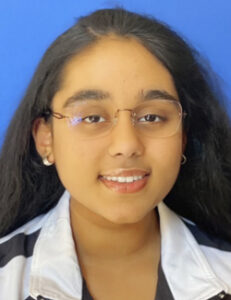
Project Background: “My father’s home town in India has many sugar factories that dump giant heaps of sugarcane bagasse outside the factories,” Vivaana says. Bagasse is the pulpy mass left after factories squeeze juice out of plant material. And there’s lots of that pulpy mass: Factories produce about three tons for every ten tons of sugarcane they process, she reports. But some energy content remains in the waste. The agriculture industry also produces lots of pulpy wastes from sorghum. That material also still has some energy content. Vivaana wondered if the wastes could help produce biofuels as an alternative to fossil fuels. If so, they could help cut down on greenhouse gas emissions that drive human-caused climate change.
Tactics and Results: Vivaana processed pulpy sugarcane and sorghum wastes so she could extract sugar materials from them. This involved grinding and steam-treating dried bagasse. Then she used an enzyme to promote hydrolysis, a chemical reaction in which water breaks one or more chemical bonds. Vivaana also grew cultures of a type of algae in a growth medium. That species of algae makes lipids that can be used to make biofuel. She added different doses of the plant waste sugars then compared the algae’s lipid production. The results showed that the optimal concentration for each type of bagasse sugar was 15 grams per liter. That’s roughly half an ounce per quart. More tests compared lipid production of algae fed with that dose of either bagasse sugar to three control groups. Algae fed either type of bagasse sugar produced the highest average amount of lipids from three culture samples. Algae fed with glucose from refined sugar had roughly eight percent more biomass. The bagasse sugars could effectively be used to help produce biofuel, Vivaana concludes.
Other Interests: Vivaana studies Hindustani classical music. She also enjoys badminton with her dad.
Career Interest: “I want to pursue a career in nanomedicine,” Vivaana says. People in that field use materials at the scale of billionths of a meter to treat disease.
Finalist
Ryan Honary
6th Grade, The Pegasus School
Huntington, California
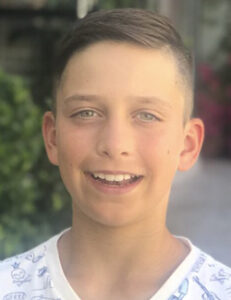
Project Background: Wildfires swept through large areas of California in 2018. One of them, called the Camp Fire, killed more than 80 people. It also destroyed thousands of structures. Much of the damage and many of the deaths happened in the first few hours. “Early detection is crucial,” Ryan says. Indeed, wildfires are becoming more of a problem worldwide as climate change continues. However, systems that rely on satellites or high-end cameras at geological stations are costly. It can also be hard to deploy those systems widely, Ryan notes. He set out to design a low-cost warning system that could be used in places around the world, including developing countries.
Tactics and Results: Ryan’s wildfire detection system uses a network of wireless solar-powered sensors. Those include fire detectors and mini meteorological stations with Raspberry Pi microcomputers. Wireless communication connects the stations and fire detectors to another computer. The computer analyzes the data and reports through a phone app. Ryan programmed the system with machine learning. He used real-world wildfire data for its training and used separate sets of Google Earth data for testing. He compared different versions of the system to see which could best predict wildfires accurately. He also aimed for a low rate of false positives. The optimal version that Ryan chose could predict wildfires with almost 71 percent accuracy. And it reported fewer than 17 percent false positives. Ryan tested the system outside with a small network of fire detectors and a mini meteorological station. Within seconds of a flame being lit near a fire detector, an alert with the location popped on Ryan’s phone screen. The system can be adapted for other purposes, Ryan adds. To show that, he replaced fire detectors with fever-detecting cameras. A similar system might help track COVID-19 or other diseases.
Other Interests: “My favorite activity is tennis,” says Ryan. He enjoys a variety of other sports as well. He also plays the piano and guitar and sings in a choir.
Career Interest: Ryan hopes to become an environmental engineer. As populations increase, people will need more resources. “Their activities will put more pressure on the environment,” he says.
Finalist
Shelby Hoobler
7th Grade, Carey Junior High School
Cheyenne, Wyoming
Leave It to Beaver Dam Analogs … to Change Soil Moisture
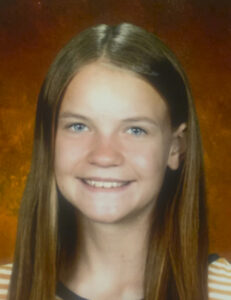
Project Background: Beavers build dams to back up water where they live. In the process, they can alter the landscape, which causes more moisture to build up in nearby soils. Shelby wondered whether a similar concept might help at a stream near her home. That stream, Dry Creek, has been subject to erosion and other degradation. As those things happen, the ratio of deeper to shallower areas changes. The water table can drop. Wetlands near the banks can dry out. And the impacts can harm biological communities. Sensitive aquatic species are particularly at risk, Shelby notes. Unless something is done, she says, harmful impacts at Dry Creek will worsen as Cheyenne continues to grow.
Tactics and Results: Last year Shelby worked with people at the Laramie County Conservation District to survey the Dry Creek stream channel. The data showed places where the water table had dropped below its former stream bed. And it showed where a pool-riffle sequence — a deeper area before a shallower one — might help with restoration. Based on the data, Shelby chose five spots for “beaver dam analogs.” She collected baseline data on soil moisture at those spots. Then she built five artificial beaver dams at those places. She hammered wooden stakes into the stream channel across its width. Then she wove willow shoots among them and filled in any leaks with rocks and moss. She visited the dams five times from October through November and measured the soil moisture in multiple spots near each of her dams. “The data showed the soil moisture percentages increased an average of 4 percent to 45 percent” for the area around each beaver dam analog, Shelby says. She has left her structures in place, so she can see how they help the channel and vegetation over time.
Other Interests: Shelby plays soccer and runs cross-country. She also enjoys hiking, horseback riding, hunting, fishing and plays the piano and viola.
Career Interest: “I want to be a biologist or a rancher,” Shelby says. She’s especially keen to learn more about Wyoming’s environment. “If I can understand the balance between land uses and nature, then I can be successful in ranching while taking care of my ranch.”
Finalist
Lucas Katz
6th Grade, Joaquin Moraga Intermediate School
Moraga, California
A Spherical Omnidirectional Motor for Electric Vehicles
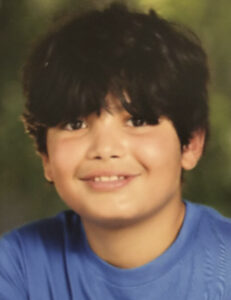
Project Background: In 2017, Goodyear Tire & Rubber announced a new concept for an automobile tire. It’s shaped like a sphere, instead of a donut, and would work on a car that can move in all directions. Lucas talked to someone with Goodyear and learned that the tire was only a concept. “Goodyear is trying to inspire others to build the motor that would work it,” he explains. Lucas had independently been thinking about making a motorized skateboard. His model would have one spherical tire propelled by a motor. He had also seen a YouTube video about a ballpoint pen with a weight-transfer bearing. Those ideas led him to design a motor that could work for Goodyear’s concept tire or his idea for a skateboard.
Tactics and Results: Electric motors work with magnets and electromagnets. The stationary part is called the stator and the spinning part is called the rotor. In a standard electromagnet, the field of the electromagnet flips with every half turn. Opposite poles attract and like poles repel each other, so the rotor spins another half turn. And the process repeats. The motor Lucas designed has a stator attached to the vehicle frame. Its rotor is in the shape of a sphere. That sphere also serves as a ball-shaped wheel. Lucas’s design stabilizes the rotor with a releasable axle. It couples the spinning rotor to the vehicle frame with magnets. Lucas’s working prototype currently rotates in only one direction. Making it work in all directions will require multiple releasable axles. For that, the motor will need magnets around the rotor’s equator and in the upper half of the stator. Lucas will also need sensors and a microprocessor for control. “Through this project, I am one step closer to achieving my dream of omni-directional vehicles,” Lucas says. “I envision that the first product for my spherical motor and wheel will be the electric skateboard of the future,” he adds.
Other Interests: “This past year I started to learn how to skateboard and I really love it,” Lucas says. His other interests include handball, soccer, tennis, basketball and blacksmithing as well.
Career Interest: Lucas hopes to become a mechanical engineer. “My passion has always been engineering and building things.”
Finalist
Snigtha Mohanraj
7th Grade, Engineering and Science University Inter-district Magnet School
West Haven, Connecticut
Effectiveness of the Organic Polymers for Removing Microplastic in an Aqueous Solution
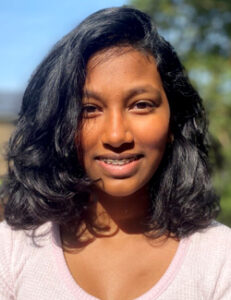
Project Background: “Our water may look clean, but actually, many microplastic pieces have contaminated it,” Snigtha says. Those are teeny, tiny bits of plastic. They don’t degrade for hundreds of years, and can contain or attract harmful chemicals. They can also build up in some organisms. During a visit to India, Snigtha saw that some processes for purifying water used Nirmali seeds. The seeds come from a type of tree. That could be an environmentally friendly way to deal with microplastics, she thought. Specifically, they could act as a coagulant, or clotting agent, to make the plastic bits clump together. “This sparked the idea of testing different natural coagulants to see which one would work the most efficiently,” she says.
Tactics and Results: Coagulants used to treat water generally have a positive charge, Snigtha says. Mixing them with negatively-charged microplastics would make the plastics become hydrophobic, or water-repelling. The plastics should then come together and settle out. Snigtha experimented with three types of natural coagulants: Nirmali seeds, shrimp shells, and cassava peels. She ground and sieved the materials. Then she stirred them in water with a magnetic stirrer. She filtered the coagulants. Then she tested each one in beakers of water mixed with common types of microplastics. One type was high-density polyethylene, or HDPE. Another was low-density polyethylene, or LDPE. The other two types of plastics were polypropylene and polystyrene. After each test, she used a microscope to count microplastics filtered out of the water samples. She also tested the turbidity, or cloudiness, of the treated water. She made a simple spectrometer, which is used to analyze samples based on different wavelengths of light. The cassava peels worked best among the three treatments. “These samples were less turbid and had the least number of microplastics remaining in them,” Snigtha says.
Other Interests: Snigtha likes watching fantasy adventure films. They “take you on beautiful journeys alongside the characters,” she says. Horseback riding, as well as volleyball, gymnastics and playing the piano and violin are a few things Snigtha enjoys.
Career Interest: Snigtha hopes to become an industrial engineer. As she sees it, “industrial engineering is where engineering gets mixed with business.”
Finalist
Anika Pallapothu
7th Grade, The Harker School
San Jose, California
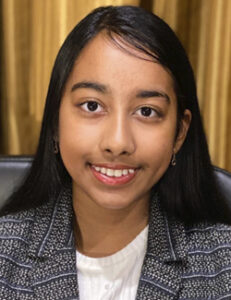
Project Background: “The leading cause of blindness is a disease called diabetic retinopathy,” says Anika. This disease affects blood vessels in the eye. Currently, detection of the disease can be complicated. Someone needs to take special digital photographs of the retina, which is at the back of the eye. Then a trained clinician must evaluate the images. Both processes call for special skills. And even if the digital images are made, getting them reviewed often takes time. Also, many areas do not have enough specially trained eye doctors. That’s a big problem for developing countries. It’s also the case in rural areas in the United States. Anika wondered if artificial intelligence, or AI, could help detect the disease. That way, more people could get timely treatment to save their eyesight.
Tactics and Results: Anika designed an artificial intelligence program to spot diabetic retinopathy. The program tells whether a digital image shows a diseased eye. If so, the program results will show its severity. To build her artificial intelligence model, she worked with an open source platform and open source library. She also downloaded 25,000 images of human retinas from a publicly available database. She resized the images and had her program label the images. The labels said whether an image showed a diseased eye, as well as the severity of any disease. Anika trained her AI model with 24,500 of the images. After initial training, she tweaked the program to reduce errors. Then she had the model go through multiple reviews of the training data. Additional tweaks taught the model which parts of an image were more important. “The final trained program had an accuracy rate of 95 percent,” Anika reports. She believes the program could also be modified to diagnose other types of eye disease.
Other Interests: Anika holds a third-degree black belt in Taekwondo. She also dances Odissi, a type of Indian dance. She also enjoys the Future Problem Solvers club, as well as speech and debate.
Career Interest: “I want to become a computer scientist,” Anika says. She hopes to develop computer science solutions for better healthcare.
Finalist
Elise Rina
8th Grade, Lake Eola Charter School
Orlando, Florida
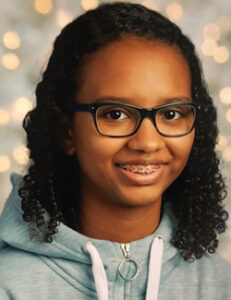
Project Background: Far too often, parents accidentally lock young children in cars. And if the car gets too hot, a child faces serious injury or death. A friend of Elise’s family once accidentally locked both her child and her keys in a car. The friend immediately saw the danger and called the police. If the car got too hot, the child could face injury or even death. “She called the police, but had to end up breaking her window because it was taking too long,” Elise says. She had seen another girl’s project, which would turn on fans in the car. But that still left the child inside. Elise set out to design a solution that would get the child out.
Tactics and Results: “I took an infant car seat and redesigned it to allow access to kids locked in cars,” Elise says. For starters, she added a pressure sensor and a temperature sensor. The temperature sensor is activated when heat inside the car reaches a preset level. If that happens and if a child is in the seat, buzzers sound off and lights flash. “But the thing that makes this project different is that the car window will lower,” Elise says. That happens because the system also connects to the motor that controls an electric car window motor. The lowered window lets cooler air into the car. It also makes it easier for someone outside the car to rescue the child. Elise used a series of if/then statements to program an Arduino circuit board to control everything. She tested her design to make sure it would work when it should, but not give off false alarms. She also made sure the buzzers were loud enough to draw attention in someplace like a parking garage. That increases the chances that someone passing by will spot the locked car and provide help.
Other Interests: Elise enjoys playing soccer and basketball. She’s also active in her local Boys & Girls Club. And she volunteers for a recycling group called Clean the World.
Career Interest: Elise hopes to become an imagineer. People with that career “get to think up new things that nobody has ever done before and then make it happen,” she says.
Finalist
Sebastian Skidmore
6th Grade, The Altamont School
Birmingham, Alabama
Vinegar and Soil: Soil Acidification Improves Growth in Simulated Martian Soil
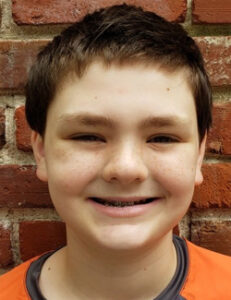
Project Background: “I watched the movie The Martian, and I liked the idea of trying to grow Earth plants on another planet,” Sebastian says. Indeed, some scientists have begun thinking about how to raise crops in greenhouses on Mars. But the soil there is full of perchlorates, he notes, “making the soil toxic and alkaline.” The pH is 8.3 or higher. “Most Earth crops grow better at a lower soil pH,” Sebastian says. He knew that acids can neutralize bases. And, he notes, “vinegar reacts strongly with bleach, a common perchlorate used on Earth.” He wondered if the use of vinegar might help increase plant growth in future Martian greenhouses.
Tactics and Results: Sebastian used a simulated Martian soil mix called MMS-1 to test how altering the pH would affect the sprouting and growth of seeds. He figured out how much vinegar it would take to change the mix’s pH to different levels. Then he set up groups of test pots with two types of lettuce seeds. One group was the unaltered MMS-1 mix. Another group had the MMS-1 mix adjusted to a pH of 7.2. A third group with MMS-1 mix had its pH adjusted to 6.5. A fourth control group used Miracle-Gro potting mix, with a pH of 6.5. Sebastian gave the plants equal amounts of light and water. He then monitored the plants for sprouting and growth for four weeks. The best sprouting and growth took place with the Miracle-Gro soil mix meant for use on Earth, he reports. Among the simulated Martian soils, the Buttercrunch lettuce sprouted and grew significantly better in the mix adjusted to a 7.2 pH, versus the other MMS-1 mixes. Results for the Red Velvet variety were less clear.
Other Interests: Sebastian bought a 3D printer with his own money and has been selling various products during the COVID-19 pandemic. Those include ear protectors for face masks, a face shield extender for dentists and a wall socket plug with a phone shelf.
Career Interest: Sebastian plans to become a biomedical engineer. He greatly appreciates the insulin pump that helps to control his insulin levels and he hopes to develop more innovations to keep people healthy.
Finalist
Joanna Sohn
8th Grade, Keystone School
San Antonio, Texas
The Effect of Probiotics and Metformin on C. elegans after Treatment in a Hypoxia Chamber: Year II
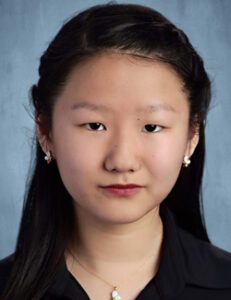
Project Background: Probiotics are live bacteria or yeast that may provide health benefits. Last year, Joanna worked with small roundworms to test how certain probiotics might help after an infection. The roundworms, C. elegans, are often used as an animal model to study biology and health. Her team found that some probiotics helped the worms after an infection, but others were harmful. This year, Joanna wondered if probiotics might help prevent or treat a condition known as ischemic heart disease. This disease occurs when too little blood and oxygen reach the heart, which can cause a heart attack. The attack can damage heart or brain tissue. More harm can happen when the necessary blood flow resumes. That’s called an ischemia-reperfusion injury.
Tactics and Results: Joanna grew C. elegans roundworms on plates with an agar growth medium and some added bacteria for food. She treated three groups of the worms with probiotics, using a different type for each group. Two other groups got different doses of metformin. People with diabetes often take that medicine to lower their risks for a heart attack. A control group of worms didn’t get any probiotic or medicine. Joanna collected data on the worms’ survival and ability to move after two and five days of treatment. That data reflected each treatment’s relative safety, compared to the control group. Then Joanna brought on an injury similar to the ischemia-reperfusion injury. She put each worm in low-oxygen conditions for 20 hours. She collected data on the worms’ survival and ability to move. Then she saw how their condition changed a day after oxygen levels became normal again. The helpful effects of one probiotic were comparable to the higher dose of the prescription medicine. Another type of probiotic was somewhat less helpful. And the third probiotic didn’t seem to help at all.
Other Interests: “I most enjoy playing the flute,” Joanna says. She also dances ballet, and likes figure skating, gymnastics, volleyball, tennis and swimming.
Career Interest: Joanna hopes to become a medical doctor. “I have been a patient many times for my asthma, eczema and severe allergies, and I would like to be able to help others in a similar situation.”
Finalist
Agastya Sridharan
8th Grade, Thurgood Marshall Middle School
San Diego, California
Quantifying the Impact of Search-Order Bias on Voting Preferences Using a Simulated Web Environment
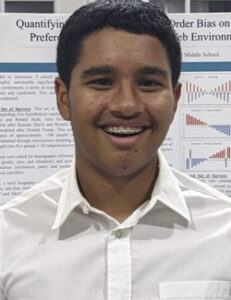
Project Background: Agastya often uses Google News and other online websites to learn about politics. He tries to find bipartisan commentary about current events. Then he learned that some politicians claimed there might be bias in online search results from Google. In late 2019, the Wall Street Journal reported that tweaks to Google’s search algorithms seemed to have the goal of shaping the results. The results concerned Agastya. The results from online search affect what people see when they look for information. But Agastya also wondered about the order in which search results show up. Might that affect voting preferences and people’s trust in different candidates? He decided to find out.
Tactics and Results: Agastya conducted two sets of surveys. Those people read biographies of hypothetical candidates. “Julia Hillard” was based on Kamala Harris. “Ronald Bush” was based on Donald Trump. The people surveyed read profiles about real presidential candidates, Joe Biden and Donald Trump. People in all the survey groups first answered if they trusted each candidate. They also noted whether they would likely vote for him or her. All the survey participants then reviewed simulated results from online searches about the candidates. The list for one group in each set went back and forth between conservative and liberal content. Two other groups in each set saw either liberal or conservative material first. And two more groups in each set saw mostly similar rankings. For those groups, however, the third and 23rd results were swapped. People were then asked again if they trusted and would likely vote for each candidate. “Search order bias does have a statistically significant impact on voting preferences,” Agastya reports, with an even greater effect among people in the “swap” groups.
Other Interests: “My favorite hobby is the Carnatic Flute,” says Agastya. He has played the instrument in national competitions and won top honors. He also plays basketball and badminton and has volunteered for a group that helps children in rural India.
Career Interest: Agastya hopes to become a psychologist. “I have always thought about why people act the way they do,” he says.
Finalist
Angela Zhan
7th Grade, Mount Logan Middle School
Logan, Utah
Discovery of Novel Soil Microbes for Efficient Plastic Degradation
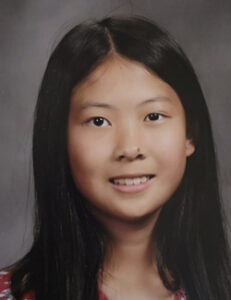
Project Background: “It’s not hard to believe that Earth will soon be covered by plastic wastes if they are not efficiently degraded,” Angela says. Billions of tons of plastic have been produced since the 1950s. In most cases, people use the plastics only once. Then most of the wastes wind up in landfills. Once there, it can take hundreds of years for some of the wastes to break down into their basic chemical building blocks. Angela would love to find and engineer novel microbes that can convert the oil-based plastic wastes into environmentally friendly materials. “As a first step, this project aimed to discover microbial strains capable of effectively degrading plastics,” she says.
Tactics and Results: Angela began her work by getting soil samples from a landfill site in northern Utah. Landfills contain lots of plastics. So, she figured, some microbes have probably already evolved to “eat” those wastes. In other words, they could get energy from breaking the plastic’s chemicals into smaller chemical units. She grew microbes from her soil samples in a potato dextrose broth. She then put some of the microbes onto a low-salt medium. The she fed the microbes only with LDPE. That’s a common plastic called low-density polyethylene. Then, the LDPE was the microbes’ only source of carbon. So, only the microbes that could get energy from it would survive. Gene sequencing in a lab let Angela identify three of those microorganisms. She also used lab methods to confirm that the three types of fungus she found were in fact degrading the plastic. The most efficient fungus was a strain of Aspergillus terreus. Angela learned that previous researchers had found that it could degrade plastic. But it is her work that first identified that the other two types of fungus also had the ability to degrade plastic., she says.
Other Interests: “My favorite sports are tennis and soccer,” Angela says. She also plays the piano and viola.
Career Interest: Angela hopes to become an environmental engineer. She is especially interested in designing environmentally friendly products. She also hopes to develop new ways to deal with existing pollutants.
